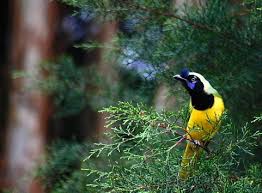
Green jay
(Cynocorax yncas)

The green jay is a bird species of the New World jays, and is found in both North and South America. Adults are about 27 cm (11 in) long and variable in colour across their range; they usually have blue and black heads, green wings and mantle, bluish-green tails, black bills, yellow or brown eye rings, and dark legs. The basic diet consists of arthropods, vertebrates, seeds, and fruit. The nest is usually built in a thorny bush; the female incubates the clutch of three to five eggs. This is a common species of jay with a wide range and the International Union for Conservation of Nature has rated its conservation status as being of "least concern".
Conservation status
Least concern
Scientific classification |
|
| Kingdom: | Animalia |
| Phylum: | Chordata |
| Class: | Aves |
| Order: | Passeriformes |
| Family: | Corvidae |
| Genus: | Cyanocorax |
| Specie: | Cyanocorax yncaa |
Description

Green jays are 25-29 cm (9.8-11.4 in) in length. Weight ranges from 66 to 110 grams (2.3 to 3.9 oz). They have feathers of yellowish-white with blue tips on the top of the head, cheeks and nape, though some taxa have more blue than others. The breast and underparts range from bright yellow in the south to pale green in the north (e.g., Texas). The upper parts are rich green. It has large nasal bristles that form a distinct tuft in some subspecies, but are less developed in others. The color of the iris ranges from dark brownish to bright yellow depending on the subspecies.
Behavior

Green jays feed on a wide range of insects and other invertebrates and various cereal grains. They take ebony (Ebenopsis spp.) seeds where these occur, and also any oak species' acorns, which they will cache. Meat and human scraps add to the diet when opportunity arises. Green jays have been observed using sticks as tools to extract insects from tree bark.
Breeding

Green jays usually build a nest in a tree or in a thorny bush or thicket, and the female lays three to five eggs. Only the female incubates, but both parents take care of the young.
Voice
As with most of the typical jays, this species has a very extensive voice repertoire. The bird's most common call makes a rassh-rassh-rassh sound, but many other unusual notes also occur. One of the most distinctive calls sounds like an alarm bell.Distribution and habitat

The green jay group occurs from southern Texas to Honduras. The Inca jay subspecies then have a disjunct home range in the northern Andes in South America.
Status
The green jay is a common species throughout most of its wide range. It is an adaptable species and the population is thought to be increasing as clearing of forests is creating new areas of suitable habitat. No particular threats have been identified, and the International Union for Conservation of Nature has rated its conservation status as being of "least concern".Zoológico de Vallarta A. C.
Leave your comments, your opinion is important to us

